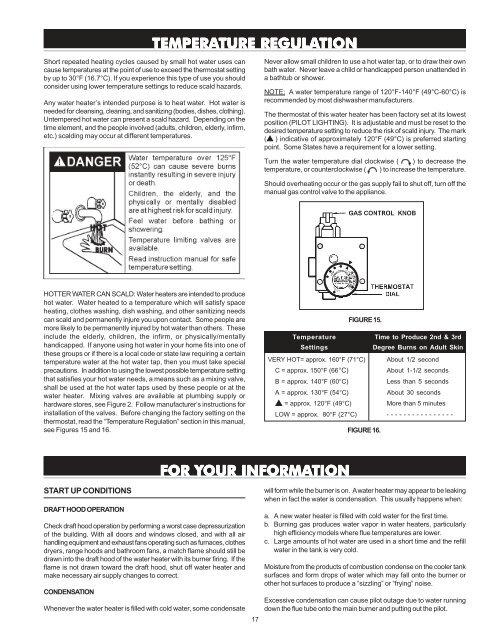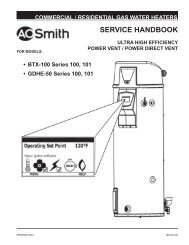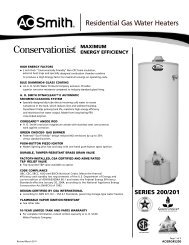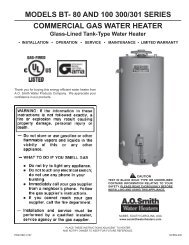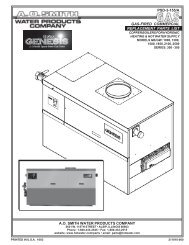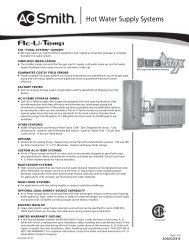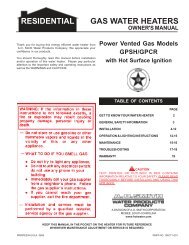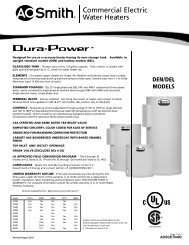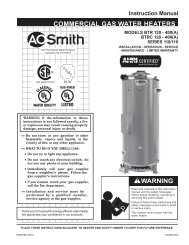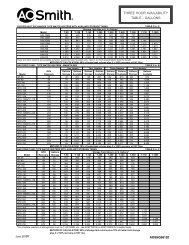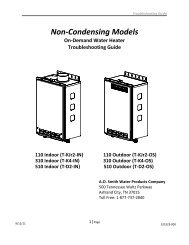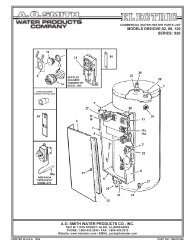Generic Single Flue 196293 002 1204.PMD
Generic Single Flue 196293 002 1204.PMD
Generic Single Flue 196293 002 1204.PMD
You also want an ePaper? Increase the reach of your titles
YUMPU automatically turns print PDFs into web optimized ePapers that Google loves.
Short repeated heating cycles caused by small hot water uses cancause temperatures at the point of use to exceed the thermostat settingby up to 30°F (16.7°C). If you experience this type of use you shouldconsider using lower temperature settings to reduce scald hazards.Any water heater’s intended purpose is to heat water. Hot water isneeded for cleansing, cleaning, and sanitizing (bodies, dishes, clothing).Untempered hot water can present a scald hazard. Depending on thetime element, and the people involved (adults, children, elderly, infirm,etc.) scalding may occur at different temperatures.TEMPERATURE TURE REGULATIONNever allow small children to use a hot water tap, or to draw their ownbath water. Never leave a child or handicapped person unattended ina bathtub or shower.NOTE: A water temperature range of 120°F-140°F (49°C-60°C) isrecommended by most dishwasher manufacturers.The thermostat of this water heater has been factory set at its lowestposition (PILOT LIGHTING). It is adjustable and must be reset to thedesired temperature setting to reduce the risk of scald injury. The mark( ) indicative of approximately 120°F (49°C) is preferred startingpoint. Some States have a requirement for a lower setting.Turn the water temperature dial clockwise ( ) to decrease thetemperature, or counterclockwise ( ) to increase the temperature.Should overheating occur or the gas supply fail to shut off, turn off themanual gas control valve to the appliance.HOTTER WATER CAN SCALD: Water heaters are intended to producehot water. Water heated to a temperature which will satisfy spaceheating, clothes washing, dish washing, and other sanitizing needscan scald and permanently injure you upon contact. Some people aremore likely to be permanently injured by hot water than others. Theseinclude the elderly, children, the infirm, or physically/mentallyhandicapped. If anyone using hot water in your home fits into one ofthese groups or if there is a local code or state law requiring a certaintemperature water at the hot water tap, then you must take specialprecautions. In addition to using the lowest possible temperature settingthat satisfies your hot water needs, a means such as a mixing valve,shall be used at the hot water taps used by these people or at thewater heater. Mixing valves are available at plumbing supply orhardware stores, see Figure 2. Follow manufacturer’s instructions forinstallation of the valves. Before changing the factory setting on thethermostat, read the “Temperature Regulation” section in this manual,see Figures 15 and 16.FIGURE 15.TemperatureTime to Produce 2nd & 3rdSettingsDegree Burns on Adult SkinVERY HOT= approx. 160°F (71°C) About 1/2 secondC = approx. 150°F (66°C)About 1-1/2 secondsB = approx. 140°F (60°C)Less than 5 secondsA = approx. 130°F (54°C)About 30 seconds= approx. 120°F (49°C) More than 5 minutesLOW = approx. 80°F (27°C) - - - - - - - - - - - - - - - -FIGURE 16.START UP CONDITIONSDRAFT HOOD OPERATIONCheck draft hood operation by performing a worst case depressurizationof the building. With all doors and windows closed, and with all airhandling equipment and exhaust fans operating such as furnaces, clothesdryers, range hoods and bathroom fans, a match flame should still bedrawn into the draft hood of the water heater with its burner firing. If theflame is not drawn toward the draft hood, shut off water heater andmake necessary air supply changes to correct.CONDENSATIONWhenever the water heater is filled with cold water, some condensateFOR YOUR INFORMATION17will form while the burner is on. A water heater may appear to be leakingwhen in fact the water is condensation. This usually happens when:a. A new water heater is filled with cold water for the first time.b. Burning gas produces water vapor in water heaters, particularlyhigh efficiency models where flue temperatures are lower.c. Large amounts of hot water are used in a short time and the refillwater in the tank is very cold.Moisture from the products of combustion condense on the cooler tanksurfaces and form drops of water which may fall onto the burner orother hot surfaces to produce a “sizzling” or “frying” noise.Excessive condensation can cause pilot outage due to water runningdown the flue tube onto the main burner and putting out the pilot.


